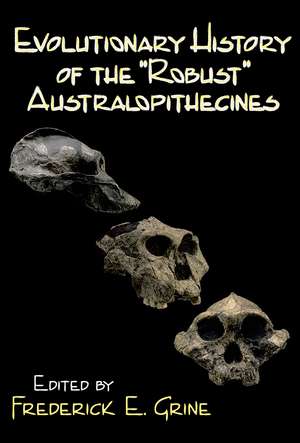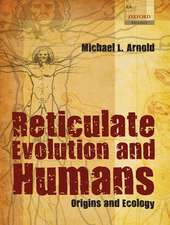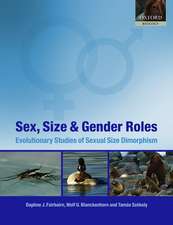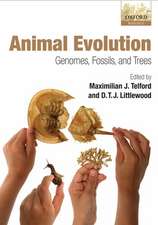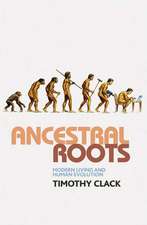Evolutionary History of the Robust Australopithecines
Autor Frederick E. Grineen Limba Engleză Paperback – 15 apr 2008
Preț: 491.48 lei
Nou
Puncte Express: 737
Preț estimativ în valută:
94.05€ • 98.44$ • 78.27£
94.05€ • 98.44$ • 78.27£
Carte tipărită la comandă
Livrare economică 31 martie-14 aprilie
Preluare comenzi: 021 569.72.76
Specificații
ISBN-13: 9780202361376
ISBN-10: 0202361373
Pagini: 550
Ilustrații: 1
Dimensiuni: 178 x 254 x 38 mm
Greutate: 0.98 kg
Ediția:1
Editura: Taylor & Francis
Colecția Routledge
Locul publicării:Oxford, United Kingdom
ISBN-10: 0202361373
Pagini: 550
Ilustrații: 1
Dimensiuni: 178 x 254 x 38 mm
Greutate: 0.98 kg
Ediția:1
Editura: Taylor & Francis
Colecția Routledge
Locul publicării:Oxford, United Kingdom
Cuprins
Foreword, Preface, Acknowledgments, List of Contributors, I. Studies of the Craniodental Evidence, 1. Enamel Thickness and Development in Australopithecus and Paranthropus, 2. Growth of Teeth and Development of the Dentition in Paranthropus, 3. Implications of In Vivo Experiments for Interpreting the Functional Significance of “Robust” Australopithecine Jaws, 4. Enlarged Occipital/Marginal Sinuses and Emissary Foramina: Their Significance in Hominid Evolution, 5. “Robust” Australopithecine Brain Endocasts: Some Preliminary Observations, 6. Growth Processes in the Cranial Base of Hominoids and Their Bearing on Morphological Similarities that Exist in the Cranial Base of Homo and Paranthropus, II. Studies of the Postcranial Evidence, 7. New Estimates of Body Size in Australopithecines, 8. Associated Cranial and Postcranial Bones of Australopithecus boisei, 9. New Estimates of Body Weight in Early Hominids and Their Significance to Encephalization and Megadontia in “Robust” Australopithecines, 10. New Postcranial Remains from Swartkrans and Their Bearing on the Functional Morphology and Behavior of Paranthropus robustus, III. Studies of Variation and Taxonomy, 11. Variation, Sexual Dimorphism and the Taxonomy of Australopithecus, 12. On Variation in the Masticatory System of Australopithecus boisei, 13. Evolution of the “ Robust” Australopithecines in the Omo Succession: Evidence from Mandibular Premolar Morphology, 14. New Craniodental Fossils of Paranthropus from the Swartkrans Formation and Their Significance in “ Robust” Australopithecine Evolution, IV. Studies of Evolutionary Relationships, 15 The Evolution of Australopithecus boisei, 16. Implications of KNM-WT 17000 for the Evolution of “Robust” Australopithecus, 17. Are “ Robust” Australopithecines a Monophyletic Group?, 18. A New Australopithecus Cranium from Sterkfontein and Its Bearing on the Ancestry of Paranthropus, 19. Numerous Apparently Synapomorphic Features in Australopithecus robustus, Australopithecus boisei and Homo habilis: Support for the Skelton-McHenry-Drawhorn Hypothesis, V. Studies of Paleogeography, Paleoecology and Natural History, 20. New Information from the Swartkrans Cave of Relevance to “Robust” Australopithecines, 21. Chronology of South African Australopith Site Units, 22. “Robust” Hominids and Plio-Pleistocene Paleogeography of the Turkana Basin, Kenya and Ethiopia, 23. Habitat Preference and Paleoecology of Australopithecus boisei in Eastern Africa, 24. The Deep-Sea Oxygen Isotope Record, The Global Ice Sheet System and Hominid Evolution, 25. Late Pliocene Climatic Events and Hominid Evolution, 26. Tooth Morphology, Wear and Diet in Australopithecus and Paranthropus from Southern Africa, 27. The Comparative Biology of “ Robust” Australopithecus: Clues from Context, 28. Divergence between Early Hominid Lineages: The Roles of Competition and Culture, 29. The Causes of “ Robust” Australopithecine Extinction, VI. Summary Comments, 30. Evolutionary History of the “Robust” Australopithecines: A Summary and Historical Perspective, Specimen Index, Subject Index
Descriere
In paleoanthropology the group of hominids known as the "robust" australopithecines has emerged. This volume focuses on the evolutionary history of these early hominids with contributions by international authorities in the field. It summarizes what has been learned about the evolutionary history of the "robust" australopithecines.
